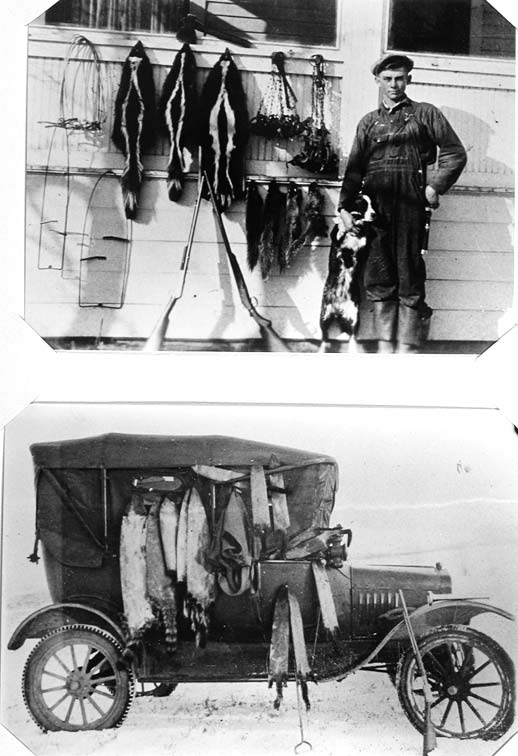Trapping and Fur Farming
Top: Donald and Perley, 1930-1931 trapping season.
Bottom: Model T with pelts from the 1931 trapping season.
Excerpt from Donald B. Johnson manuscript:
"One day, in the fall, Howard [Melby] and I decided to drive all the roads in the country and look for skunks in the culverts. This was before the Depression and skunks were about $1.50 then. We were going to drive my Model T one day and his Model T the next day, but the day he was going to drive he suggested that we drive my car because it had a box on it instead of a back seat, and he would buy the gas.
"We drove all that day, too, had our 'dinners' with us, and we didn't find any skunks. I suppose a lot of other trappers had already looked in those culverts. We did find a dead coon in one (probably chased by dogs and crawled in there to die). That night Howard handed me 50 cents for the day's gas.
"My first animals in confinement were three skunks. I caught them in traps up on Lee's ... and brought them home one at a time in a gunnysack, and put them in a brooder house where the shop is now. I didn't tell anyone what I was doing. I sure smelled 'skunky,' but I smelled 'skunky' during the trapping season anyway. (I had to leave my 'outside' overalls outside, of course, but people weren't as sensitive about smells in those days.)
"There was a knot hole in the brooder house about two inches across, and Pa noticed that our little black and white dog (Perley) would stand completely motionless for long periods with her nose in that knot hole, smelling the good, rich skunk air, and the truth came out.
"One night the skunks squeezed out through the bottom of the door (it only had a latch high up) and got away. One even went clear back up to the original den and got back in the original trap again, but it got skinned that time!
"I was checking muskrat traps in the dark with a flashlight early in the spring when I met a skunk out in the open. I killed it with a stick and took it home and skinned it. That was the worst I ever smelled, but a least it was 'honorable work' so Ma put up with it. She squawked a lot, but there wasn't much she could do.
"We had a stack of silage on the field behind the school-house that year and after I skinned the skunk we went to town and got a load of that steamy silage. On the way home we went up to the Elevator to get something. You should have heard the elevator man (Gilford Slotsve) holler about how I stunk! He said he had never smelled anything so strong as that particular combination of skunk and hot silage.
"We got a new Model T in 1913 (the year I was born), and traded for a new one in 1916 and again in 1921. That was our car until we got an Essex late in 1928. The 1921 had battery lights and a self-starter and was really modern, as compared to the other hand-crankers, but they were all open touring cars with side curtains for bad weather.
"Howard Melby and I used to go spearing suckers in the spring. We would get up about 3:30 a.m. and be out to the creeks before daylight to get those that had come into creeks during the night and were hiding in the deeper holes.
"I couldn't have the Model T pickup to drive after dark, but I could take it fishing before daylight. Ma must have thought the dark wasn't as bad toward morning.)" [10.48-5]
Previous • Next • Contents • About • Sitemap • Home
